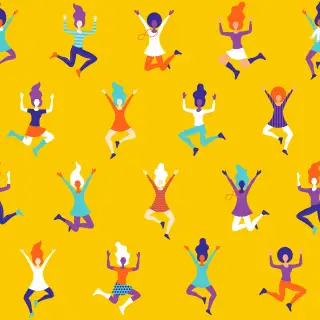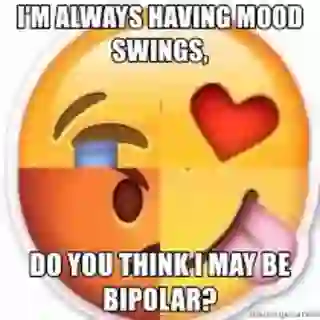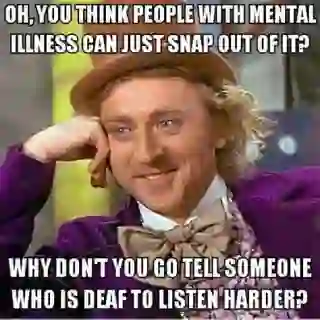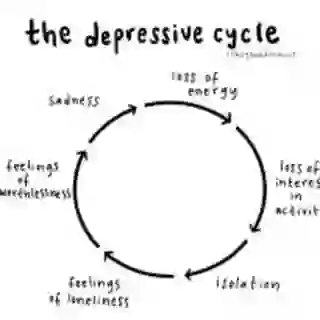9 Memes That Explain Bipolar
Yes, we're going there. Sometimes there's just no better way to describe what it's really like to have bipolar.

Bipolar is one of those conditions where people think they know what it is, but there are a lot of misconceptions. Part of the bad info comes from the way it's portrayed in the media. Add to that the fact that it's used as an adjective in everyday conversations: "I'm so bipolar." To help frame the facts around bipolar, we've pulled together several memes that represent different facets of the illness. Our intention is to debunk bad information and progress the conversation around bipolar, not to reinforce these myths. There's still a lot of research being done on the exact biomarkers for bipolar as well as the link between bipolar and creativity. Click through the slideshow, below, to see some of the highlights on what we do know.

WHEN PEOPLE SAY SOMEONE IS SO BIPOLAR BECAUSE THEY'RE MOODY
Let's set the record straight. Bipolar is not about having a roller coaster ride of emotions every hour. In fact, longitudinal research has shown that the average mood episode lasts over three months. Some people with bipolar (about 20-40 percent) do have what's technically called "mixed-features specifier." The DSM-4 used to identify this as mixed episodes, which in a way is easier to understand, but it was updated in the DMS-5. Picture being ramped up, full of energy, but also self-loathing and sad at the same time. That's an example. And, suicide risk is especially high when both mania and depressive symptoms are happening at the same time. Meme courtesy of memegenerator.net

FINALLY BEING DIAGNOSED IS A RELIEF
About 3 percent of the U.S. population suffers from bipolar, but recent research has shown as many as another 7.3 percent could be undiagnosed. The reason is twofold: in some cases the symptoms are not extreme enough to look for treatment; in other cases, people only seek help during their down cycles. Meme courtesy of memesmonkey.com

RIGHT, BECAUSE THAT'S WHAT BROUGHT ME HERE...
One of the challenges to treating bipolar is the tendency to want to hang on to the high parts. It almost has the effect of offsetting the depression, so letting go of it can be scary. Meme courtesy of quickmeme.com

THE SEROTONIN STRUGGLE IS REAL
Several neurotransmitters have been implicated in bipolar, not just serotonin. Other neurotransmitters linked to the condition are: dopamine, norepinephrine, serotonin, GABA (gamma-aminobutyrate), glutamate, and acetylcholine. Even the brain structure itself is different. Meme courtesy of memegenerator.net

THIS IS NOT MY BIPOLAR TALKING
During the euphoric stage, a person may feel a surge of energy and along with that a feeling of heightened self-esteem, like they can do anything. And, there may be some justification for that: researchers like Kay Redfield Jamison, PhD, co-director of the Mood Disorders Center at Johns Hopkins University, have linked hypomania with creativity. It wasn't a surprise when a large 2010 study found that people with bipolar disorder were disproportionately concentrated in the most creative fields. Beyond knowing there is an association between bipolar and creativity, experts have not pinpointed exactly why or how. A leading theory is that hypomania increases ambition and that's what leads to creativity. Meme courtesy of memegenerator.net

SURE, I CAN DO THAT...AND THAT, OH, AND HOW ABOUT THAT...
Another trait of the manic cycle is being flooded with ideas that come and go quickly. That coupled with the exuberance described earlier makes focus really difficult. It also almost always ends with an emotional crash. Meme courtesy of Imageflip.com

SLEEP, WHO NEEDS SLEEP?
Changes in sleep patterns are often the first symptoms people notice. During a manic cycle, that can mean not wanting to sleep or feeling like you can't sleep because you're too busy with all the things you're thinking about doing. In the depressive cycle, it could take the form of insomnia or too much sleep. Meme courtesy of Meme

THE DEPRESSIVE CYCLE DOMINATES
People with bipolar spend more time dealing with depression than mania. According to one study from the University of California San Diego, people with bipolar I experience depression three times as often as mania. For those who have bipolar II, it's 40:1. Meme courtesy of knowyourmeme

WELL HELLO THERE AGAIN, BIPOLAR BEAR
Relapse, unfortunately, is likely with bipolar. There have been several studies examining just how often it may recur, and most experts settle around it being 70 percent likely to come back within four to five years. Among the triggers for a new episode are: a big life event (not necessarily a stressful one), drug and alcohol use, lack of sleep, and too much stress. Meme courtesy of makeameme.org
Bipolar mood 'swings' last a long time: Arch Gen Psychiatry (2010). "Longitudinal course of bipolar I disorder: Duration of mood episodes."
Doctors miss a lot of of cases of bipolar: Angst J, Azorin J, Bowden CL, et al. Prevalence and Characteristics of Undiagnosed Bipolar Disorders in Patients With a Major Depressive Episode: The BRIDGE Study. Arch Gen Psychiatry. 2011;68(8):791–799. doi:10.1001/archgenpsychiatry.2011.87
Just how prevalent is bipolar?: https://www.nami.org/learn-more/mental-health-conditions/bipolar-disorder.
Bipolar is more prevalent in creative fields: Econ Hum Biol (2010). "Brainstorm: Occupational Choice, Bipolar Illness And Creativity."
Depressive symptoms occur more often: J Affect Disord (2003). "The Prevalence And Disability Of Bipolar Spectrum Disorders In The US Population: Re-Analysis Of The ECA Database Taking Into Account Subthreshold Cases."
Bipolar can recur: Eurpoean Psychiatry (2015). "Relapse Rates and Risk Factors of Bipolar Disorder: Conclusions of a Naturalistic 4 Year Follow-up Study."